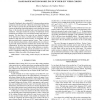Free Online Productivity Tools
i2Speak
i2Symbol
i2OCR
iTex2Img
iWeb2Print
iWeb2Shot
i2Type
iPdf2Split
iPdf2Merge
i2Bopomofo
i2Arabic
i2Style
i2Image
i2PDF
iLatex2Rtf
Sci2ools
ICASSP
2007
IEEE
2007
IEEE
Hash-Based Motion Modeling in Wyner-Ziv Video Coding
Generally, Distributed video coding (DVC) schemes perform motion estimation at the decoder side, without the current frame being available. In order to generate the side-information reliably, one solution consists in allocating a limited bit budget to send a hash of the current frame. At the decoder, this auxiliary hash is used to perform motion estimation. This paper studies the accuracy of hash-based motion estimation and compares it to conventional encoder-side motion estimation. We show that, at low rates, the very limited bit-budget of the hash does not ensure a reliable motion estimation, while at medium to high rates the motion accuracy is comparable with the finite precision used to represent motion vectors. Then, we derive the rate-distortion characteristic, which combines the cost of encoding the hash and the prediction residuals after decoder-side motion compensation. We show that, at high rates, hash-based motion modeling can virtually achieve the same coding efficiency ...
Hash-based Motion | Hash-based Motion Estimation | ICASSP 2007 | Motion Estimation | Signal Processing |
| Added | 02 Jun 2010 |
| Updated | 02 Jun 2010 |
| Type | Conference |
| Year | 2007 |
| Where | ICASSP |
| Authors | Marco Tagliasacchi, Stefano Tubaro |
Comments (0)

